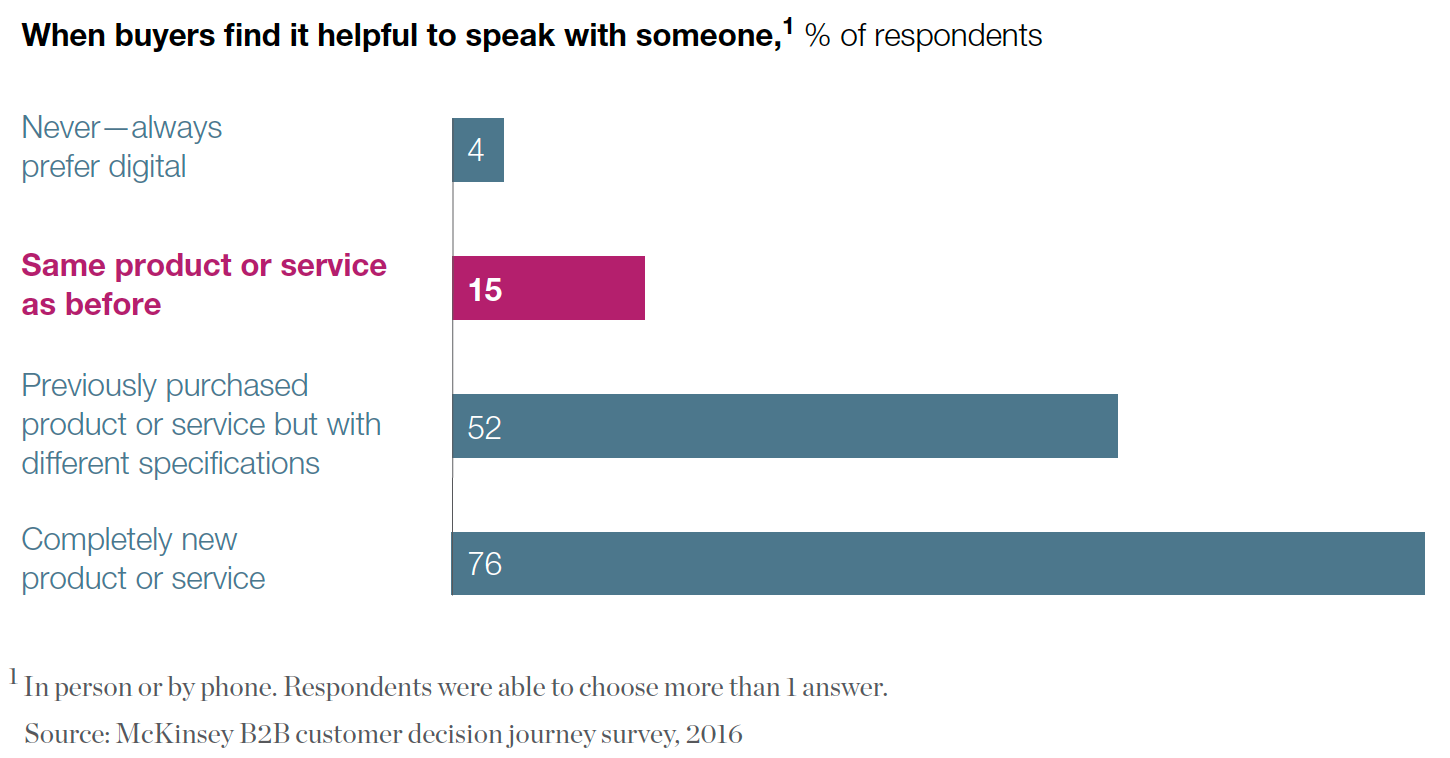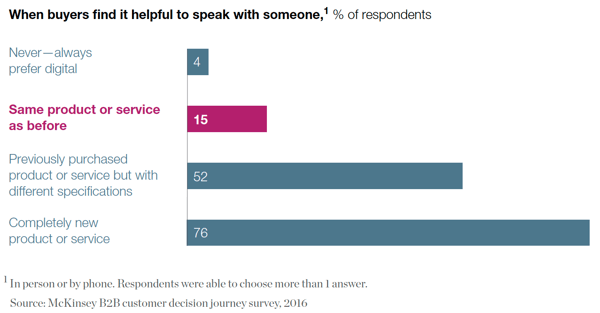When your customers DO want to speak to a sales person
October 31, 2018

There’s been a great deal of comment – often from people and organisations who frankly should know better – about how today’s B2B customer doesn’t want to engage with a sales person until late in their consideration.
That comment is based on studies and statistics that appear to show that the average potential customer is variously 57%, 60% or more than 70% through their decision-making journey before they see value in a sales conversation.
But no customer is “average”. And those simplified statistics and headlines – supported by naïve and often self-serving interpretations from people and organisations attempting to peddle a particular point of view – hide a much more nuanced reality.
When you dig into the facts behind the facts, a much more complex reality emerges...
I’m no great fan of averages. They often act as a comfortable crutch to support stupidly simple assertions that deny the complexity of the real world. H. L. Mencken observed that “for every complex problem there is an answer that is clear, simple, and wrong”.
And that is certainly true in this case. Never mind the fact that in complex B2B sales our success depends on engaging multiple stakeholders who each may have different perspectives and be at different points in their personal decision journeys – there are other patterns at play here.
Let’s briefly deal with the obvious one: if a sales person is already engaged with the prospect prior to the start of their current decision journey – either though a previous sale or a previous buying cycle that never came to closure – they have a better chance of early involvement this time around.
A spectrum of complexity
But let’s also recognise that there is a spectrum of complexity in the types of buying cycle the prospect may be engaged in. McKinsey published a compelling analysis last year (“When B2B buyers want to go digital – and when they don’t”) that highlighted the impact that decision type has on buying behaviour, and on the desire to have a 1:1 interaction with a sales person.
Yes, the results are themselves averages, but they indicate the potential for very different levels of engagement (and very different sales strategies):

- On average, only 15% of B2B buyers that were involved in a repeat purchase of the same product or service as they had bought before saw value in being able to speak with a sales person.
- When the purchase of an otherwise similar product or service involved a change in specification, the average number of B2B buyers that saw value in having a sales conversation rose to 52%.
- And when the B2B buyers were looking for a completely new product or service – something they had never bought before – the average figure rose to 76%.
The only thing that surprises me about the latter is that the figure is so low. In complex, high-value, never-bought-it-before, high-risk decisions, you’ve got to wonder about the quality of the decisions that the remaining 24% are making.
Invest in digital and people
There’s an obvious conclusion here: sales organisations need to invest heavily in digital assets that directly support and simplify what their customers regard as simple B2B purchases. If those customers do not see the need to interact with a sales person, they shouldn’t have to.
But there’s an opposite conclusion when it comes to complex B2B sales – organisations need to invest heavily in recruiting, training and enabling sales people to support complex B2B buying decisions, most particularly when the purchase is breaking new ground for the customer.
Carving a path through the clutter
Given all the digital clutter that these prospective customers will often have to wade through when they do their research through internet search, I believe that there’s an argument that complex conversational skills, supported by genuine business acumen, have never been more important in high-end new business and new project sales.
And it’s never been more important to start having these conversations at an early stage in the prospective customer’s decision journey. If the first time we engage is after the customer has issued an RFP or tender document, we’ve either probably already lost, or have a very low chance of winning.
The argument for early engagement
Our influence is at its most powerful when we engage while the customer currently appears satisfied with the status quo, when they are starting to explore their options, or while they are defining what their future solution ought to look like and how to choose between their options.
Once they are locked into the selecting phase (often signalled by the presence of that RFP or tender) our room for influence or manoeuvre is dramatically limited. No amount of negotiation training or cute closing techniques is going to help us. Someone else’s fingerprints are already on the prize...
But it’s not as simple as focusing our sales people on engaging early (or ensuring that our marketers see it as their prime responsibility to get the customer to want to have a sales conversation sooner rather than later).
Making good use of their time
We need to ensure - in that all-important first conversation – that our customer sees value in continuing the dialogue. We won’t achieve that by delivering a tedious company or product pitch. We won’t achieve that by talking about us.
The only way we can reliably ensure that the first interaction leads to an ongoing conversation is to share something that proves to be of value to them. Something that makes them think “that conversation was a really worthwhile use of my time”.
That’s why business acumen, curiosity, active listening, context and the ability to share relevant experiences are such important foundations for compelling sales conversations. These are the things that make customers pleased that they decided to talk to a sales person.
It's good to talk!
And if you want a justification for engaging early, let me throw another average at you: Forrester found that nearly three-quarters of B2B buying decisions went in favour of the vendor that had done the most to influence the customer’s vision of a solution.
Don’t be misled or waylaid by the siren voices proclaiming that customers don’t want to talk to you early on. Under the right circumstances, they do, and they see value in your involvement.
But please don’t destroy their trust by delivering a crude company or product pitch. You’ll screw it up for yourselves, and probably for every sales person that attempts to follow you.
On average, in complex new B2B purchases, engaging early in the right way is the right thing to do. But if you would like a more nuanced conversation about how these principles apply to your own organisation, please get in touch...
ABOUT THE AUTHOR
 Bob Apollo is a Fellow of the Association of Professional Sales, an award-winning blogger, a confident and entertaining event speaker and workshop leader, a regular contributor to the International Journal of Sales Transformation and the founder of UK-based Inflexion-Point Strategy Partners, the B2B value-selling experts.
Bob Apollo is a Fellow of the Association of Professional Sales, an award-winning blogger, a confident and entertaining event speaker and workshop leader, a regular contributor to the International Journal of Sales Transformation and the founder of UK-based Inflexion-Point Strategy Partners, the B2B value-selling experts.
Following a varied and successful career spanning start-ups, scale-ups and corporates Bob now works as an adviser to some of today’s most ambitious B2B-focused sales organisations, equipping and enabling them to accelerate revenue growth and transform sales effectiveness by implementing the proven principles of value-based selling.


Comments